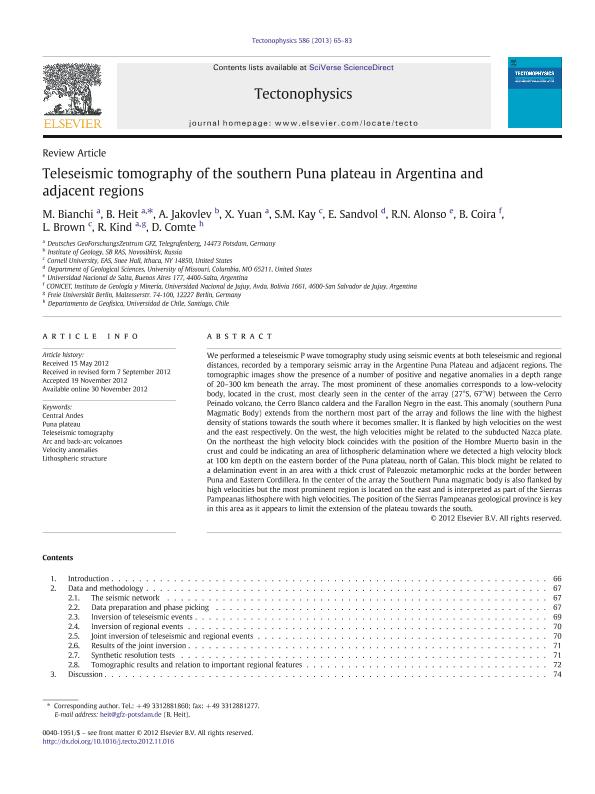Artículo
Teleseismic tomography of the southern Puna plateau in Argentina and adjacent regions
Bianchi, M.; Heit, B.; Jakovlev, A.; Yuan, X.; Kay, S. M.; Sandvol, E.; Alonso, Ricardo Narciso ; Coira, Beatriz Lidia Luisa
; Coira, Beatriz Lidia Luisa ; Brown, L.; Kind, R.; Comte, D.
; Brown, L.; Kind, R.; Comte, D.
 ; Coira, Beatriz Lidia Luisa
; Coira, Beatriz Lidia Luisa ; Brown, L.; Kind, R.; Comte, D.
; Brown, L.; Kind, R.; Comte, D.
Fecha de publicación:
02/2013
Editorial:
Elsevier Science
Revista:
Tectonophysics
ISSN:
0040-1951
Idioma:
Inglés
Tipo de recurso:
Artículo publicado
Clasificación temática:
Resumen
An array of 74 seismological stations was deployed in the Argentine Puna and adjacent regions for a period of two years. The aim is to investigate the seismic structure in the crust and upper mantle in order to address fundamental questions regarding the processes that form, modify and destroy continental lithosphere and control lithospheric dynamics in this part of the Central Andes. This portion of the Central Andes is an ideal locale to address these questions given that there is geologic evidence that there has been recent lower crustal and mantle lithospheric delamination. We performed a teleseismic P wave tomography study using seismic events at both teleseismic and regional distances. The tomographic images show the presence of a number of positive and negative anomalies in this region. The most prominent of these anomalies corresponds to a lowvelocity body, located in the crust, in the center of the array (approximately at 27°S, 67°W) between the Cerro Peinado volcano, the Cerro Blanco caldera and the Farallon Negro in the east. This anomaly (southern Puna Magmatic Body) is flanked by high velocities on the west and the east respectively. On the west, this high velocity block might be related to the subducted Nazca plate. On the east, it coincides with the position of the Hombre Muerto basin in the crust and could be indicating an area of lithopheric delamination where we detected a high velocity block at 100 km depth on the eastern border of the Puna plateau. This block might be related to a delamination event in an area with a thick crust of Paleozoic metamorphic rocks from the Eastern Cordillera. We observed lower velocities in the Puna lithosphere that could be indicative of magma chambers derived from the ascent of fluids and melts from the top of the subducted plate probably induced by delamination. Beneath the oceanic Nazca plate, a low-velocity zone can be observed at depths greater than 200 km. The origin of this low velocity anomaly remains unclear but it could be caused by portions of asthenospheric material in the uppermost mantle. The position of this low velocity zone is in agreement with previous observations in the same area that have suggested the presence of a hot asthenospheric mantle upwelling induced by slab flattening. Keywords: Central Andes, Puna plateau, teleseismic tomography, arc and back-arc volcanoes, velocity anomalies, lithospheric structure.
Palabras clave:
Teleseismic
,
Tomography
,
Andes
,
Puna
Archivos asociados
Licencia
Identificadores
Colecciones
Articulos(CCT - NOA SUR)
Articulos de CTRO.CIENTIFICO TECNOL.CONICET - NOA SUR
Articulos de CTRO.CIENTIFICO TECNOL.CONICET - NOA SUR
Articulos(CCT - SALTA-JUJUY)
Articulos de CTRO.CIENTIFICO TECNOL.CONICET - SALTA-JUJUY
Articulos de CTRO.CIENTIFICO TECNOL.CONICET - SALTA-JUJUY
Articulos(INSUGEO)
Articulos de INST.SUP.DE CORRELACION GEOLOGICA
Articulos de INST.SUP.DE CORRELACION GEOLOGICA
Articulos(SEDE CENTRAL)
Articulos de SEDE CENTRAL
Articulos de SEDE CENTRAL
Citación
Bianchi, M.; Heit, B.; Jakovlev, A.; Yuan, X.; Kay, S. M.; et al.; Teleseismic tomography of the southern Puna plateau in Argentina and adjacent regions; Elsevier Science; Tectonophysics; 586; 2-2013; 65-83
Compartir
Altmétricas



